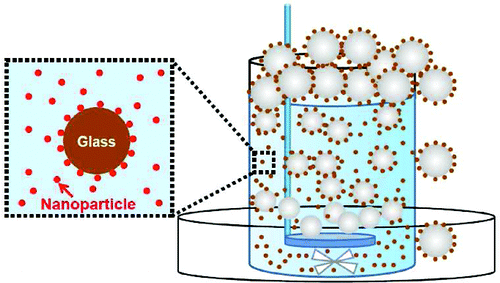New technology for recovering valuable minerals from waste rock

Researchers report discovery of a completely new technology for more efficiently separating gold, silver, copper, and other valuable materials from rock and ore. Their report on the process, which uses nanoparticles to latch onto those materials and attach them to air bubbles in a flotation machine, appears in the ACS journal Langmuir.
Robert Pelton and colleagues explain that companies use a technique termed froth flotation to process about 450 million tons of minerals each year. The process involves crushing the minerals into small particles, and then floating the particles in water to separate the commercially valuable particles from the waste rock. The water contains "collector" substances that can attach to the valuable particles, causing them to repel water and rise to the bubbling top of the water where they can be easily skimmed off.
The researchers demonstrated an entirely new type of collector technology, consisting of water-repelling nanoparticles. In laboratory experiments using glass beads to simulate actual mineral particles, they showed that the nanoparticles attached so firmly to the beads that flotation produced a recover rate of almost 100 per cent.
More information:
Nanoparticle Flotation Collectors: Mechanisms Behind a New Technology, Langmuir, 2011, 27 (17), pp 10438–10446
DOI: 10.1021/la2016534
Abstract
This is the first report describing a new technology where hydrophobic nanoparticles adsorb onto much larger, hydrophilic mineral particle surfaces to facilitate attachment to air bubbles in flotation. The adsorption of 46 nm cationic polystyrene nanoparticles onto 43 μm diameter glass beads, a mineral model, facilitates virtually complete removal of the beads by flotation. As little as 5% coverage of the bead surfaces with nanoparticles promotes high flotation efficiencies. The maximum force required to pull a glass bead from an air bubble interface into the aqueous phase was measured by micromechanics. The pull-off force was 1.9 μN for glass beads coated with nanoparticles, compared to 0.0086 μN for clean beads. The pull-off forces were modeled using Scheludko’s classical expression. We propose that the bubble/bead contact area may not be dry (completely dewetted). Instead, for hydrophobic nanoparticles sitting on a hydrophilic surface, it is possible that only the nanoparticles penetrate the air/water interface to form a three-phase contact line. We present a new model for pull-off forces for such a wet contact patch between the bead and the air bubble. Contact angle measurements of both nanoparticle coated glass and smooth films from dissolved nanoparticles were performed to support the modeling.
Provided by American Chemical Society


















